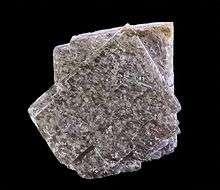Sanidine
Sanidine is the high temperature form of potassium feldspar with a general formula K(AlSi3O8).[1] Sanidine is found most typically in felsic volcanic rocks such as obsidian, rhyolite and trachyte. Sanidine crystallizes in the monoclinic crystal system. Orthoclase is a monoclinic polymorph stable at lower temperatures. At yet lower temperatures, microcline, a triclinic polymorph of potassium feldspar, is stable.
| Sanidine | |
|---|---|
 Sanidine - Puy de Sancy, Monts-Dore massif, Puy-de-Dôme, Auvergne, France. (5x4.5cm) | |
| General | |
| Category | Feldspar |
| Formula (repeating unit) | K(AlSi3O8) |
| Strunz classification | 9.FA.30 |
| Dana classification | 76.01.01.02 |
| Crystal system | Monoclinic |
| Crystal class | Prismatic (2/m) (same H-M symbol) |
| Space group | C2/m |
| Identification | |
| Color | Colorless to white |
| Crystal habit | Tabular crystals, may be acicular |
| Twinning | Carlsbad twinning common |
| Cleavage | {001} perfect, {010} good |
| Fracture | Uneven |
| Tenacity | Brittle |
| Mohs scale hardness | 6 |
| Luster | Vitreous, pearly on cleavage |
| Streak | White |
| Diaphaneity | Transparent to translucent |
| Specific gravity | 2.52 |
| Optical properties | Biaxial (-) |
| Refractive index | nα = 1.518 - 1.525 nβ = 1.523 - 1.530 nγ = 1.525 - 1.531 |
| Birefringence | δ = 0.007 |
| 2V angle | Measured: 18° - 42° (low); 15° - 63° (high) |
| References | [1][2][3] |
Due to the high temperature and rapid quenching, sanidine can contain more sodium in its structure than the two polymorphs that equilibrated at lower temperatures. Sanidine and high albite constitute a solid solution series with intermediate compositions termed anorthoclase. Exsolution of an albite phase does occur; resulting cryptoperthite can best be observed in electron microprobe images.
References
- "The New IMA List of Minerals – A Work in Progress – Updated: March 2014" (PDF). Archived from the original (PDF) on March 25, 2014.
- http://www.mindat.org/min-3521.html Mindat.org
- http://www.webmineral.com/data/Sanidine.shtml Webmineral data
- Hurlbut, Cornelius S.; Klein, Cornelis, 1985, Manual of Mineralogy, 20th ed., Wiley, ISBN 0-471-80580-7